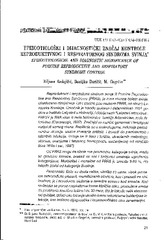Приказ основних података о документу
Epizootiological and diagnostic significance of porcine reproductive and respiratory syndrome control
Epizootiološki i dijagnostički značaj kontrole reproduktivnog i respiratornog sindroma svinja
| dc.creator | Radojičić, Biljana | |
| dc.creator | Đuričić, Bosiljka | |
| dc.creator | Gagrčin, M. | |
| dc.date.accessioned | 2020-12-14T08:43:45Z | |
| dc.date.available | 2020-12-14T08:43:45Z | |
| dc.date.issued | 2002 | |
| dc.identifier.issn | 0350-2457 | |
| dc.identifier.uri | https://vet-erinar.vet.bg.ac.rs/handle/123456789/1911 | |
| dc.description.abstract | The porcine reproductive and respiratory syndrome (PRRS) is a new viral disease in swine, designated exclusively under the acronym PRRS by the European Commission in 991. The cause of this disease was isolated and determined in 1991 at the Lelystad Institute in The Netherlands as Lelystad retrovirus. The PRRSV is an RNA virus of the order Nidovirales, the family Arteriviridae, the genus Arterivirus (Cavanaugh, 1997). Different genomic and phenotypic varieties of the virus are significant. It is replicated in macrophages; it induces permanent viraemia, causes the creation of antibodies, and leads to persistent and latent infections. It is isolated from tonsil tissue, alveolar macrophages, the uterus, and fetal homogenate composed of different tissues (Wills et al., 1997). All production categories of swine can contract PRRS, but pregnant sows, suckling piglets, and fattening swine are considered endangered categories. Morbidity and mortality is between 8-80%, which also depends on the animal category. Economic damages are substantial when one considers the high percentage of still-born piglets, mummified fetuses and suckling piglets. Irregular successive cycles in sows are also expressed. In fattening swine, in addition to a respiratory form of the clinical picture, the time period until animals reach abattoir weight is extended even up to 30 days, whichisalsoaconsiderableeconomicloss. Costs of treating possible secondary bacterial infections, diagnostics and immunoprophylaxis are not negligible. The OIE placed PRRS on the B list in 1992 as a contagious disease of swine which incurs economic losses in almost all countries of the world. Diagnosis is made by isolating and determining the virus and/or by serodiagnostics (ELISA and PCR). Certain countries have already made up protocols for the implementation of constant diagnostics and suggested eradication measures (Dee S.A. et al., 2000). In our country, the first clinical cases of PRRS were recorded in Herceg Novi in 1998 (Radojicic Biljana et al., 2002). It is our opinion that the implementation of PRRS diagnostics must begin in our country as well, especially since the disease has a clinical Picture which is similar to swine plague, so that wrong diagnoses are possible. | en |
| dc.description.abstract | Reproduktivni i respiratorni sindrom svinja ili Porcine Reproductive and Respiratory Syndrome (PRRS), je nova virusna bolest svinja, ekskluzivno dizajnirana 1991 godine pod nazivom PRRS, od strane Evropske Komisije. Uzročnik je takođe izolovan i determinisan 1991 godine u Institutu Lelystad u Holandiji, i dobija naziv „Lelystad arterivirus“. PRRSVje RNA virus iz reda Nidovirales, familije Arteriviridae, roda Arterivirus (Cavanaugh, 1997). Značajni su različiti genomskii fenotipski varijeteti samog virusa. Replikuje su u makrofagama, indukuje permanentnu viremiju, izaziva stvaranje antitela, i dovodi do perzistentnih i latentnih infekcija. Izoluje se iz tkiva i tonzila, alveolarnih makrofaga, uterusa, ovarijuma i fetusnog homogenata sastavljenog od različitih tkiva (Wills i sar., 1997). Od PRRS mogu da obole sve proizvodne kategorije svinja, mada se gravidne krmače, prasad na sisi i tovljenici smatraju ugroženim kategorijama. Morbiditet i mortalitet od PRRSje između 8-80 %, što takođe zavisi od kategorije životinja. Ekonomske štete su dosta velike, ukoliko se uzme, visok procenat mrtvorođeneprasadi, mumificiranih plodova, kao i prasadi na sisi. Izraženo je i neredovno ulaženje u naredne estruse kod krmača. Kod tovljenika se pored respiratorne forme kliničke slike produžava vreme do postizanja klanične težine i do 30 dana, što je takođe velik ekonomski gubitak. Izdaci oko lečenja ukoliko krenu sekundarne bakterijske infekcije, kao troškovi dijagnostike i imunoprofilakse nisu zanemarljivi. PRRS je 1992 godine postavljen od strane OIE na B listu kao kontagiozna bolest svinja, koja pravi ekonomske gubitke u skoro svim zemljama sveta. Dijagnoza se postavlja izolacijom i determinacijom virusa ili/i serodijagnostikom (ELISA i PCR). Neke zemlje su već sačinile i protokole o sprovođenu konstantne dijagnostike i predložile mere eradikacije (Dee S. A. i sar., 2000). U našoj zemlji su zabeleženi prvi klinički slučajevi PRRSu Herceg Novom 1998 godine (Radojičić Biljana i sar., 2002). Mišljenja smo, da se mora početi sprovoditi dijagnostika PRRS i u našoj zemlji, posebno zbog toga što bolest klinički liči i na svinjsku kugu, pa su moguće i zamene istih bolesti. | sr |
| dc.language | en | |
| dc.publisher | Fakultet veterinarske medicine, Beograd, Srbija | |
| dc.rights | openAccess | |
| dc.rights.uri | https://creativecommons.org/licenses/by/4.0/ | |
| dc.source | Veterinarski Glasnik | |
| dc.source | Veterinarski Glasnik | |
| dc.subject | epidemiološki | |
| dc.subject | dijagnostički | |
| dc.subject | značaj kontrole | |
| dc.subject | PRRS | |
| dc.subject | epizootiological | |
| dc.subject | diagnostic | |
| dc.subject | importance of control | |
| dc.subject | PRRS | |
| dc.title | Epizootiological and diagnostic significance of porcine reproductive and respiratory syndrome control | en |
| dc.title | Epizootiološki i dijagnostički značaj kontrole reproduktivnog i respiratornog sindroma svinja | sr |
| dc.type | article | en |
| dc.rights.license | BY | |
| dcterms.abstract | М, Гагрчин; Босиљка, Ђуричић; Биљана, Радојичић; Епизоотиолошки и дијагностички значај контроле репродуктивног и респираторног синдрома свиња; | |
| dc.citation.volume | 56 | |
| dc.citation.issue | 1-2 | |
| dc.citation.spage | 21 | |
| dc.citation.epage | 31 | |
| dc.identifier.doi | 10.2298/VETGL0202021R | |
| dc.identifier.fulltext | https://vet-erinar.vet.bg.ac.rs/bitstream/id/5250/bitstream_5250.pdf | |
| dc.type.version | publishedVersion |

